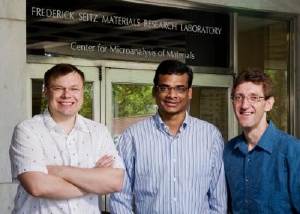May 27 2009
A team of researchers at the University of Illinois has demonstrated that, counter to classical Newtonian mechanics, an entire collection of superconducting electrons in an ultrathin superconducting wire is able to "tunnel" as a pack from a state with a higher electrical current to one with a notably lower current, providing more evidence of the phenomenon of macroscopic quantum tunneling.
 Physics professors Alexey Bezryadin, left, and Paul Goldbart flank graduate student Mitrabhanu Sahu, who performed the bulk of the measurements. Credit: L. Brian Stauffer
Physics professors Alexey Bezryadin, left, and Paul Goldbart flank graduate student Mitrabhanu Sahu, who performed the bulk of the measurements. Credit: L. Brian Stauffer
Physics professors Alexey Bezryadin and Paul Goldbart led the team, with graduate student Mitrabhanu Sahu performing the bulk of the measurements. Their research was published on the Web site of the journal Nature Physics on May 17.
Quantum tunneling is the capability of a particle to inhabit regions of space that would normally be off-limits according to classical mechanics. This research observes a process called a quantum phase slip, whereby packs of roughly 100,000 electrons tunnel together from higher electrical current states to lower ones. The energy locked in the motion of the electrons as they phase slip is dissipated as heat, causing the nanowires to switch from a superconducting state to a more highly resistive one.
It's through this switching of states that allows the tunneling of the phase slip to be observed, the researchers say.
Goldbart, who is also a researcher at the university's Frederick Seitz Materials Research Laboratory, describes a quantum phase slip as a phenomenon that allows the spatially extended structure of superconductivity "to undergo a kind of quantum mechanical rip or tear, one where the entire extended behavior of the superconductivity tunnels its way through a classically forbidden set of configurations."
"Semiconductors, insulators and metals all hinge upon the ability of particles to make it through classically forbidden regions, despite apparently having negative kinetic energy there, as quantum physics allows," Goldbart said.
In Newton's world, according to Goldbart, particles would be reflected from such regions.
Although quantum mechanics governs the realm of atoms and molecules and smaller, quantum phenomena sometimes "leak up" to macroscopic scales, he said.
The ultrathin superconducting nanowires fabricated and measured by Sahu and his co-researchers are about 2,000 times finer than a single strand of human hair, which is still "a substantially larger scale than where one typically expects to observe quantum tunneling," Bezryadin said.
According to Bezryadin, who is also a researcher at the Beckman Institute and the Illinois Micro and Nanotechnology Laboratory, it has long been established that single electrons can tunnel, but scant evidence has existed until now for the group tunneling of a large ensemble of superconducting electrons confined in a thin wire.
"Observing switching events in superconducting nanowires at high-bias currents provides strong evidence for quantum phase slips," Bezryadin said. "Our experiments provide further evidence that the laws of quantum mechanics continue to govern large systems, composed of many thousands of electrons, acting as a single entity."
Both researchers believe that the practical implication of knowledge gleaned from research into quantum tunneling could have applications in the field of quantum computing.
"If we learn how to evade the factors that currently suppress quantum superpositions at the macro-scale," Bezryadin said, "we would be better positioned to construct quantum bits for quantum computers, which could perform tasks with an enormous increase in speed and security."
Funding for this research was provided by the U.S. Department of Energy through the Frederick Seitz Materials Research Laboratory and the Institute for Condensed Matter Theory, both at the University of Illinois.